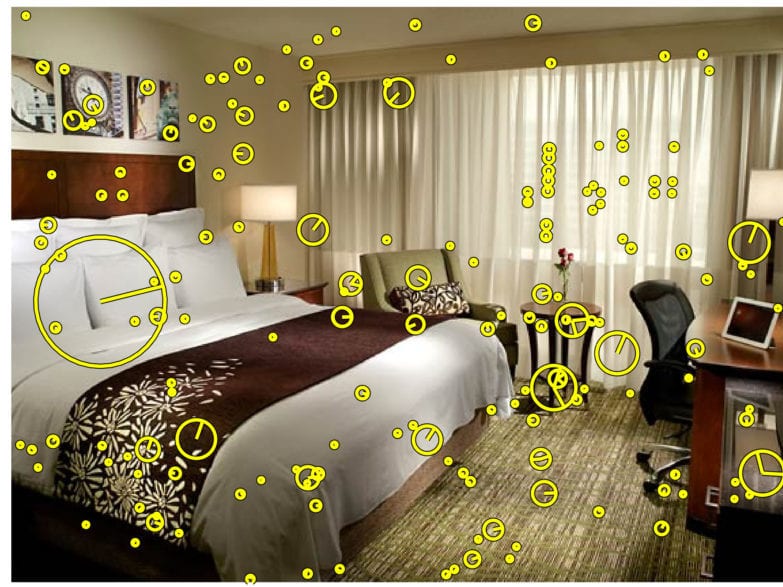A young girl poses provocatively in a dark hotel room. For a set fee, any willing customer can pay to have sex with her.
For investigators attempting to track down sex traffickers and their victims, these online advertisements can contain critical clues.
The smallest of details in a room could give away its location, but there are too many ads for law enforcement to scan each of them for clues.
That’s where TraffickCam comes in. It’s a simple phone app that uses crowdsourced snapshots of hotel rooms to help law enforcement locate victims and prosecute sex traffickers.
TraffickCam application
Any travelers pit stopping at a hotel can turn on their phone’s GPS location and upload photos of the room from four different angles to TraffickCam’s database.
The idea is that law enforcement agencies can then check adverts featuring suspected trafficking victims in hotel rooms against TraffickCam’s database of photos.
TraffickCam’s image analysis tools transform the photos into a number of data points, using features such as patterns on the carpet, paintings on the wall and landmarks out of the window. The various data points in the photos play an important role in matching the location.
TraffickCam is the brainchild of Exchange Initiative and a team of researchers at Washington University. Congregation of the Sisters of St. Joseph provided a $100,000 matching grant to begin development of the app, and private donations are made through the non-profit St. Louis Community Foundation.
“This is an easy way for citizens to take a stand against sex trafficking by simply taking photos,” Kimberly Ritter, director for development for Exchange Initiative, tells CNN.
Since launching in June 2016, Ritter says that more than 150,000 hotels have been added to the TraffickCam database.
“We have over 100,000 people using the app right now, and we’re hoping that more will join us to take action and fight this fight,” she says.
Tracing the traffickers
But even if the database identifies the location of a hotel room, Ritter says it is “luck of the draw” whether the victim is still there. This is because traffickers often post photographs from one location to advertise services in another, she explains.
Another strategy is for traffickers to base themselves in a central location and post ads in multiple cities. They then drive the girls to different cities, depending on where they get responses to the ads.
“Local girls that are working locally with local pimps will be using local photos, the majority of the time,” Sergeant Adam Kavanaugh, supervisor of the St. Louis County Multi-Jurisdictional Human Trafficking Task Force, tells CNN.
In these cases Kavanaugh imagines TraffickCam could help investigators identify the hotel to prepare an effective sting operation.
But when it comes to tracking down what Kavanaugh calls the “travelers” — trafficking victims that are moved all around the United States — the app may be more useful in showing movement across state lines.
“We can then make a federal case because of the inter-state commerce,” says Kavanaugh.
This could result in a longer sentence for a convicted trafficker.
Putting TraffickCam to the test
Before the app can be rolled out to law enforcement agencies across the United States, it is being tested by Kavanaugh and the St. Louis County Police Department.
“Right now we’re just beta testing the St Louis area, and we’re getting positive hits,” he says, referring to ads that match hotel room photos in the database.
Following initial testing in this small area, Kavanaugh feels optimistic about the role TraffickCam can play in identifying both hotel rooms and routes traffickers are using.
“Technology drives everything we do nowadays, and this is just one more tool that law enforcement can use to make our job a little safer and a little bit easier,” he says.
Ritter hopes the app will be available to all law enforcement in the US by Spring 2017, and will eventually be available worldwide.
“With this being such new and cutting-edge technology, we need to perfect it here in the States and then we’ll look to making it globally accessible,” says Ritter.
Global users can already download the app and upload photos to the database. Ritter says that all photographs uploaded on TraffickCam from all over the world are being stored for future use.
Why hotels?
The US National Human Trafficking Hotline found hotels and motels to be a common venue for sex trafficking, with nearly 10 percent of known trafficking cases reported to them in 2016 taking place in a hotel or motel — although Polaris, which operates the hotline, believes the real figure is much higher. Just under 10 percent of cases were commercial-front brothels, and in nearly eight percent of cases the venue was unknown. Less than five percent of cases were street-based.
The app will only be able to narrow in on exact locations if enough photos are added to the database, but Ritter firmly believes people will continue to add them.
“It’s amazing how many people are interested in fighting this atrocity,” she says.
“The more of us that join together to fight this crime, the better the opportunity we have to eradicate it.”
CNN ©February 2017
